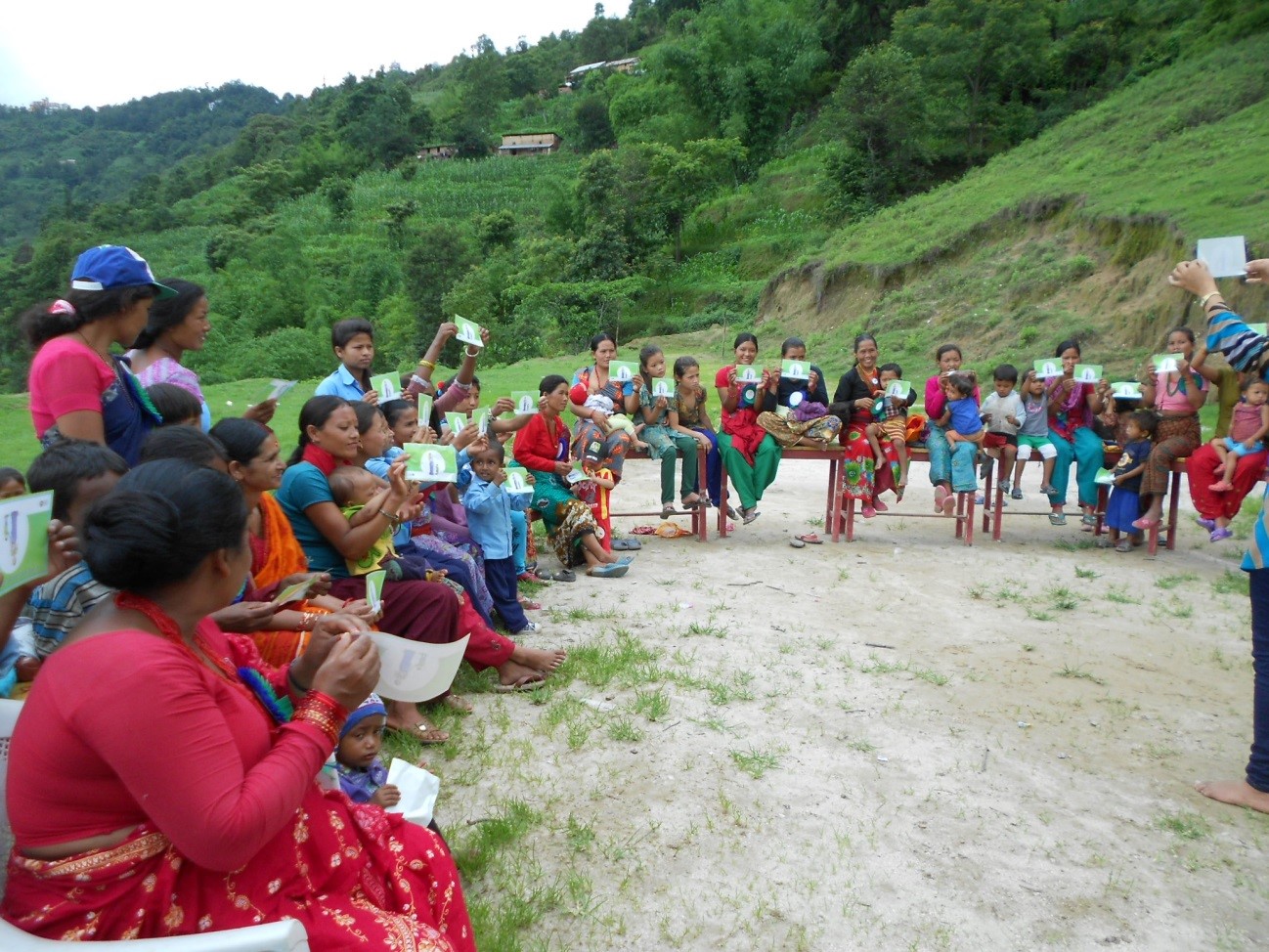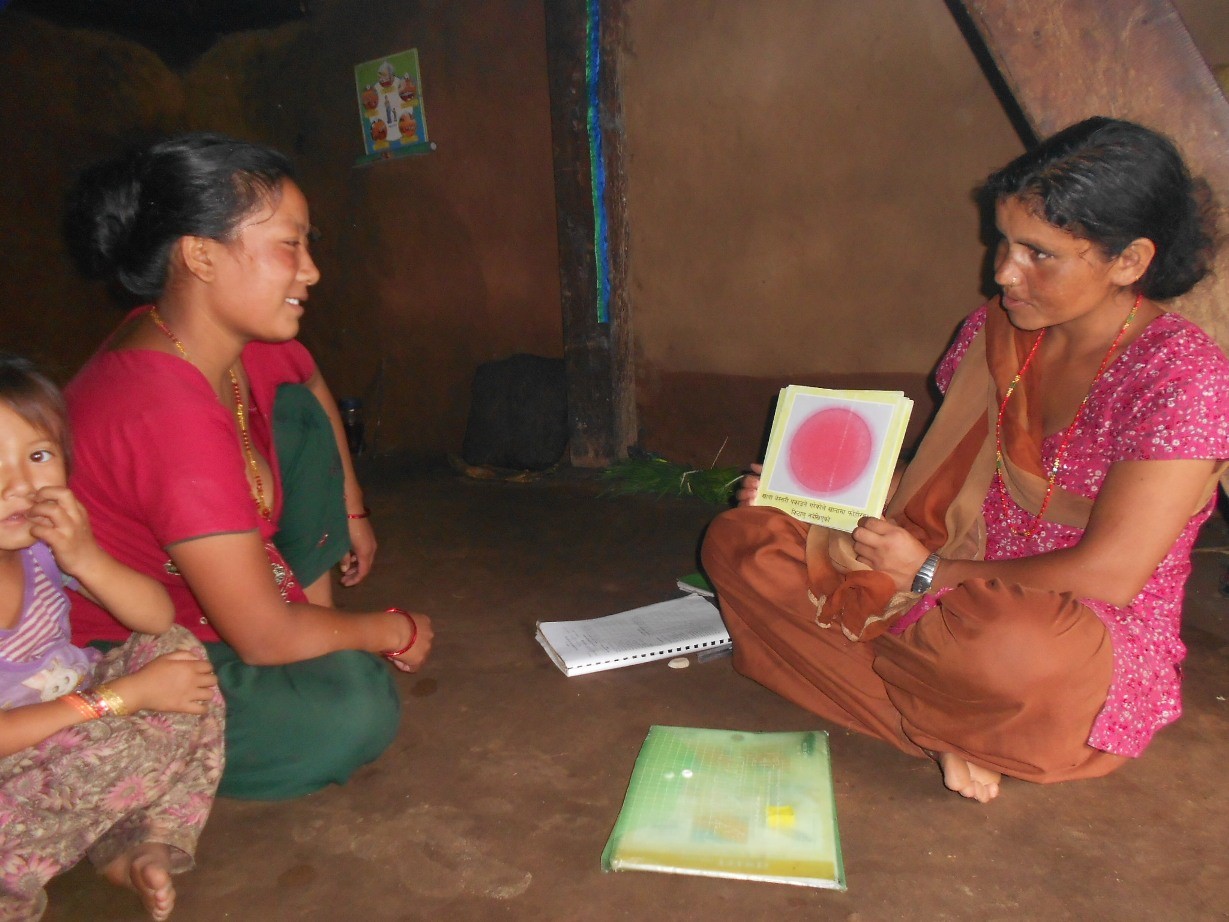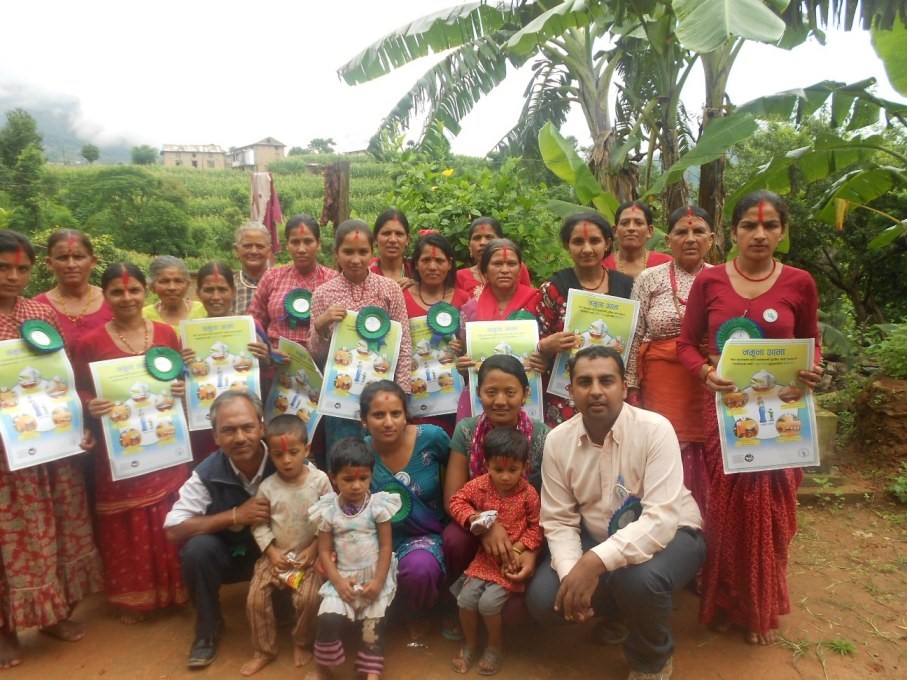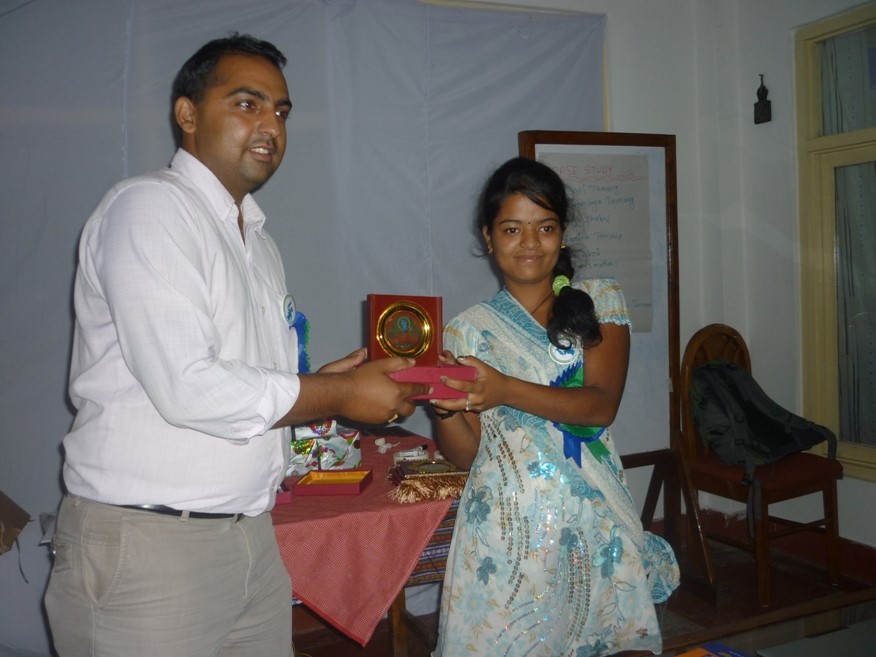Om's Food Hygiene Intervention - August 2013

Trial underway
I have been in the field during the last three months for the trial, with limited connectivity, but am pleased now to be able to share my reflections and some photos from the community/group events and household visits.
The first household visit: After launching a food hygiene intervention trial in each cluster and creating a campaign movement, which I discussed in my earlier blog, our FHMs carried out the first household visit in each intervention household (with a total of 120 households). This visit was instrumental to changing the physical settings in the kitchen. It was common to find the kitchen area set within the household’s only room, which was used for everything from cooking and sleeping to keeping animals, from buffalos to chickens. After cleaning this room, the kitchen area was demarcated with coloured ribbon and flags were put up highlighting the five key food hygiene behaviours that are encouraged. To remind mothers about these behaviours and reinforce them, small eye danglers, an ‘ideal mother’ board and Dhungro were put up in specific places in the kitchen. The danglers were put-up in the area where the behaviours should be encouraged, so that a ‘hand washing’ dangler was next to the kitchen hand washing station, the ‘thorough cooking’ dangler was placed in the cooking area, and the ‘symbol-of-milk’ dangler in the nearby milk storage area. After the kitchen makeover, the FHM highlighted the importance of the five food hygiene behaviours and diarrhoeal prevention mechanisms by showing the mother the 3D flip chart. The programme song was installed as a ring tone on the mothers’ mobile phone, for those who had one. This process was carried out in each intervention household within 15 days of the first community event.



The first group event: Following the first household visit, the first group event was organized in each of the 12 sub-clusters. The main purpose was to involve the mothers to practise the five key food hygiene behaviours, introduce the 3M petrifilm, glo-germ, as well as the message bibs, and start the ‘clean kitchen’ competition. The practical demonstration session was instrumental in ensuring that mothers performed all key behaviours properly. The use of 3M PetriFilms was key to demonstrating how thorough cooking and re-heating kills bacteria. The use of glo-germ inon the hands of mothers and children before feeding eally illustrated the importance of hand washing. The introduction of the bib containing messages like ‘did you wash your hands before feeding me?’ was really innovative. At the end of the session, the ‘clean kitchen’ competition and the indicators used for judging it were announced, and mothers were given a month within which to get their kitchen ready. The FHM showed households the visit schedule, which constitutes one visit to each household every 15 days.


The second household visit: This visit was undertaken in each household during cooking time and the FHM reinforced all the actions performed during the group event. Mothers were also reminded about the ‘clean kitchen’ competition and encouraged to win.
The second group event: By the time of the second group event, there was lots of excitement and enthusiasm among them towards the programme. This event was organized in a public place, and we used nurture as a key motivational factor to change the food hygiene behaviours of mothers through real life demonstrations, such as, for example, the ‘Child Life Game’, folk songs and puzzle games. The session began with the usual campaign ritual of cutting nails, washing hands, dancing to the campaign song and sharing experiences. Following this, a ‘Child Life Game’ was performed, where the consequences of whether or not a mother practises all five food hygiene behaviours were demonstrated, including what will happen to their children in the future. To play, the FHMs highlighted a situation: Krishna’s mother followed all five food hygiene behaviours while he was growing up so that Krishna was successful when he reached 8 years, 16 years, 25 years and 29 years of age. On the other hand, Hira’s mother didn’t follow the behaviours and Hira was unsuccessful in life. The mothers were amazed to see the real differences in life progress between the two characters played out in front of them. Almost all mothers said that ‘they want a child like Krishna and they will make it happen by performing all five behaviours’. The ‘folk song competition’ was engaging, lively and humorous. The mothers sang the song they had composed using food hygiene messages and danced. At the end the ‘ideal mother’ competition was announced, and the indicators for it were shared. Mothers were given one month to work towards these and compete for the title. A fan reflecting all five behaviours was also provided to mothers to remind them of the indicators.



The third household visit: Through this visit, the FHM observed and guided re-heating practices of different food, so that mothers were able to understand how much time is needed to properly re-heat different foods. Mothers were also encouraged to use the kettle to boil water and to boil the milk each time they feed their child. An interactive discussion using 3D flip charts and 3M PetriFilm was also performed with the mother and household family members. Mothers were encouraged to win the ‘clean kitchen’ and ‘ideal mother’ competitions. During this period, mother’s kitchens were closely monitored by the FHM, Research Assistant, Coordination Committee members and myself, using clean kitchen indicators.


The third group event: Mothers were curious to attend this session because the winner of the ‘clean kitchen’ competition was to be announced. In this event, we used disgust as a motivational factor to change mother’s behaviours by doing a ‘disgust exercise’, using glo-germ to internalise how the germs can be transmitted from mother’s hands to serving utensils, the child’s food, and finally to the child’s stomach. We also played the hot potato game which showed how social exclusion results from unhygienic food behaviours. In addition, we used social pledging and respect as a motivational factor to change behaviours. Almost 85% of mother’s won the ‘clean kitchen’ competition. The winners received a prize, a congratulation poster, and shared their success story. All participants visited the winners’ houses to observe the clean kitchen. Those who didn’t win this time got an extra 15 days to clean their kitchen based on clean kitchen indicators. At the end, the “safe food hygiene zone” competition was announced. This is and an intra-cluster competition.


The fourth household visit: The fourth household visit was a little different from the previous one. A peer review exercise, also known as the watch-dog exercise, was performed. The mothers observed each other’s behaviours and reported back the outcomes to the FHM. This way, mothers were peer pressurized to perform all five behaviours. Mothers were also reminded of the ‘ideal mother’ and ‘safe food hygiene zone’ indicators and encouraged to participate in the competitions.


The fourth group event: This was again an interesting event for all participating mothers because the ‘ideal mother’ title would be awarded for those who had been practising all five key food hygiene behaviours. In this event, we used social respect and affiliation as a motivational factor to change mothers’ food hygiene behaviours through an innovative letter exchange, family members role-play, and public pledging for those who won the ‘ideal mother’ title. A surprise letter from an unknown mother of a neighbouring village came to the participating mother. The letter, sent by a mother called ‘Dhukhimaya’, was read out, highlighting the problems she is facing because her child has been getting frequent diarrhoea over the last few months. The mothers felt that they should support Dhukhimaya and sent back a letter to her after intensive discussion about possible solutions. This was a really emotional moment. A ‘role play’ by mothers acting as a key household family member to highlight the social, environmental and attitudinal barriers related to food hygiene behaviours was also performed. Among four role play mothers, one performed the role of an ideal mother showing a positive attitude and action towards all key behaviours, another performed the role of a positive but ignorant husband, another performed the role of a resistant child, and yet another of a mother in-law with an ignorant and resistant character. The idea was to demonstrate how an ‘ideal mother’ can overcome these different barriers at home to be able to practice all five behaviours. There was lots of excitement and enthusiasm when 99% of the mothers won the ‘ideal mother’ title. Mothers who won received a prize, and their photos were put up in the village junction for their social respect and pride.



The fifth household visit: In this visit, the FHM observed mothers’ behaviours and asked them to self review their performance in front of other family members, neighbouring people and the FHM. In the end, mothers were reminded about the ‘safe food hygiene zone’ indicators and their role in making the cluster a ‘safe food hygiene zone’. During this visit, mothers were also asked which particular session and tools they like more and want to observe again in the final community event. During the trial period, a few school events were also conducted in those schools within the intervention clusters, and various planning and review meetings were conducted with the FHMs to assess the ongoing progress as well as to properly plan for the different events.

The second and closing community event: Mothers as well as villagers were really excited to attend this event. Altogether four community events were conducted in four intervention clusters. The closing event reinforced ideal behaviours. It was instrumental in declaring the cluster a safe food hygiene zone, sharing programme success stories, and publically pledging mothers, coordination committee members and all supporters to continue their good work. The event also began with the campaign ritual described above. Guests from different institutions attended the event such as professionals from the Ministry of Health & Population, the WaterAid Nepal Country Representative, VDC secretaries, local health institution heads, coordination committee members, local teachers and social leaders. There was very good attendance by mothers and family members, as well other villagers.


A reply letter received from Dhukhimaya was read-out saying that she had found the fellow mothers’ suggestions extremely useful and that her child no longer had diarrhoea. The sessions which mothers had reported to have found the most useful and motivational throughout the campaign were performed again at this event, including the ‘Child’s Life Game’, the folk song competition and the role play.


As Principal Investigator for the study, I highlighted and shared the operational learning, and the success of the programme, as well as the challenges faced during the trial implementation. The huge “wow!” came when 11 out of the 12 sub-clusters were declared as a ‘safe hygiene zone. Mothers were really pleased to receive a safe food hygiene zone billboard and they made a public commitment to sustain the five behaviours as well as to maintain the safe food hygiene zone. For continuous follow-up and monitoring, volunteer mothers were selected from each sub-cluster. On behalf of the programme, I publically pledged all mothers, coordination committee members, research assistants, FHMs, local social leaders and distributed a “certificate of appreciation”. It was also exciting to listen to the positive words on how the campaign was an inspiration, to hear the thanks from all guests and coordination committee members, and to receive good bye tikas and mala from mothers.

To fix the static ‘safe food hygiene zone’ billboards in the respective places, all participants and guests marched towards the village chanting ‘safe food, healthy child’, ‘ideal mother hi hi, diarrhoea bye bye’. The rally was huge and mothers were singing the song and dancing using local music. When the event was over, mothers and our staff were really emotional when saying goodbye.

The sixth household visit and a two-day review meeting on completion of the trial: In this visit, the three month household-level action plan was reviewed. A household-level sustainability workplan was also developed. Mothers and family members were motivated to continuously sustain food hygiene behaviours and optimum utilization of received materials. Key learnings, field experiences and the challenges faced by the FHMs were documented through a two-day residential review meeting. The usefulness of all tools as well as the most exciting and not so exciting things were also noted. Experience certificates and tokens of appreciation were provided to all FHMs, and local stakeholders and team members recognizing their valuable contribution to the programme. I heartily appreciated the tireless efforts and work done by the FHMs and their contribution throughout the trial periods. Dr Val Curtis also joined in the final review meeting through Skype and thanked all FHMs for their hard work throughout the intervention period. Among the FHMs, the best food hygiene motivators and most progressive motivators were also celebrated and were highly appreciated for their contribution. The FHMs were really emotional when they were saying goodbye and I felt the same.

